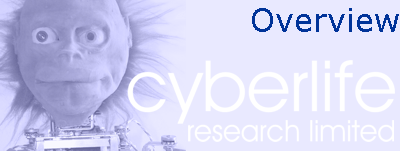
|
|
|
Lucy's raison d'etre, scientifically and technologically speaking, is to study a possible neural mechanism for generating mental imagery and "imagination". Unlike very simple creatures, we primates (and almost certainly other mammals too) don't live in the real world at all - we live in a virtual world inside our heads. We like to think we are aware of what is going on around us, but it's more accurate to say that we are only aware of what we believe is going on around us. In other words, the world we think we see and hear is really our own internal model - our interpretation - of the world outside. When we make plans or visualise the effects of our actions, we are making use of this mental model to predict the future - the model acts out events in our virtual world, to tell us how the physical world is likely to behave. Even when we perform a simple movement we don't usually have to think about the individual muscles that need to be controlled - we simply imagine the movement to have happened in our heads, and all the physical muscles do the right things automatically (something William James called ideomotor action). Most of the things that we care deeply about - our dreams, our aspirations, our minds and our concern for other people's feelings - depend on our ability to build models of the world inside our heads. When we put ourselves in someone else's shoes we are really putting them into ours, by using our mental model of our own body and mind to make judgements about what is likely to be happening in theirs. Imagination is what makes us into psychological entities, rather than just biological ones.
All of the machines we have so far built for ourselves, including those that lay claim to the title "artificial intelligence", lack this capacity to any significant degree. Yet without internal mental models, machines cannot make predictions, form hypotheses or reason by analogy, to mention only a few of their limitations. Part of the reason for the Lucy project is to explore ways in which machines could be given the capacity for imagination, and hence become more intelligent, adaptable, robust and user-friendly. There are, roughly speaking, two different approaches to artificial intelligence at the moment: one tries to create high-level reasoning by explicitly programming symbolic rules for it into a computer. The other, more modern variety, takes more account of biology and self-organisation (through evolution, say), but has little to say about creatures more complex than an ant. Lucy is an attempt to find a middle way: a biologically inspired and plausible approach to the replication of higher level, mental phenomena. Her intelligence is not "programmed in" - after all, pre-programmed behaviour is, by its very nature, unintelligent. But nor is she a mere reactive machine, with all the wit and intellectual sophistication of a stick insect. Her intelligence is an emergent consequence of the interactions between thousands of simulated neurons, and, moreover, it is learned, rather than given to her a priori. She won't ever be very smart, but it might not be too far from the truth to say that she will eventually have a mind of her own, albeit a very, very stupid one.
|
Copyright © 2004 Cyberlife Research Ltd. |